Journal of Tourism & Hospitality
Open Access
ISSN: 2167-0269
ISSN: 2167-0269
Research Article - (2020)Volume 9, Issue 5
This paper aims to present and discuss the potential tourism resources of Dorzé village in southern Ethiopia. The research was conducted in 2018 through qualitative methods. Field data were collected by field observation and interviews with tourists, local community, local tourism experts, local tour guides, as well as local potters’ and weavers’ association members. Thematic analysis technique was used and the results were qualitatively described with some supporting photographs. The findings of the study revealed that Dorzé village is endowed with worthwhile cultural tourism attractions. The Dorzé handcraft tradition such as hand weaving, pottery work, and elephant-shaped house building, cultural festivals, traditional music and instruments, and the process of making food from false banana trees and culinary experiences are identified as the most important cultural tourism resource of the village. On the other hand, lack of tourism infrastructures such as road, bank, water, and electric power supply is identified as a stumbling block for cultural tourism development of the area. Besides, the lack of accommodations provision is identified as the other bottleneck of tourism development in the area. The research suggests that local and national tourism stakeholders need to work on local cultural tourism resources to increase the cultural tourism significance in Dorzé village.
Cultural tourist attractions; Accessibility and tourism infrastructure; accommodations; Dorzé village; South Ethiopia
Ethiopia is a land of wonder and fascination, a country with one of the richest histories in the African continent as well as in the world with more than three thousand years of history, and home to friendly people who descended from some of the world’s oldest civilizations. Most part of the country is diversified with both natural and cultural potential tourism resource: natural attractions include some of the highest and lowest places in Africa along with immense wildlife including a significant variety of endemic ones. Moreover, the cultural attraction which includes very old and well preserved historical traditions with mesmerizing style, churches, and castles.
What's more, the country has more than 80 ethnic groups with respective language and life-style, religious attractions with colorful and unique holiday celebrations. The country was recognized by the European Council on Tourism and Trade (ECTT) as “The World Best Tourist Destination and Favorite Cultural Destination in 2015” [1]. There are a lot of cultural tourist attractions in different parts of the country, which are not yet well documented. Dorzé village is one of the destinations that are neglected by researchers and tourism stakeholders.
Dorzé village is located in Gamo highlands in southern Ethiopia. Dorzé is a community, part of a larger ethnic group known as Gamo, who are Omotic-speaking, who in turn belong to the larger Afro-Asiatic language family. Before the 20th century, the people were organized into districts known as guta and sub clans known as qomo. The districts were corporate units ruled by assemblies and ritually led by an appointed halaqa. Halaqa is elected based on an amount of wealth and his ability (title is open only for males) to prepare an extravagant feast to please his community so as to get favors for election [2]. With an altitude of 2900-3000 km above sea level with an annual rainfall of 9000-1110 mm with an average temperature of 18°C, Dorzé people cultivate different types of cereals, pulses, and horticultural crops. Dorzé highlanders practice intensive plow farming. The agricultural activity is mainly subsistence-oriented and aided by traditional farm implements and rich indigenous farming and land management techniques which are accumulated over many generations [3]. In addition to agriculture, the Dorzé people also depend on handcraft especially weaving. In this village, every individual has the chance to acquire the skill of weaving as a cultural practice. Young children are taught weaving by their family members. By the time they complete primary school, most of them become good weavers.
Tourism does not occur randomly; it occurs with knowing and using its potentials. Any tourism activity in a region cannot begin unless resources are identified, categorized, assessed, and realized [4]. Scholars used some criteria to evaluate and categorize the tourism potential in a given destination. For example, the potential of a site for development as a tourist attraction can be evaluated into two distinct features: physical features, such as sea, landforms, mountains, hills, inland water, coasts, and forests, and cultural features, such as culture, lifestyle, art, handicrafts, and heritage [5,6].
Tourist potentials also encompass basic tourism infrastructure and services and facilities which fulfill the needs of visitors [7]. Tourism elements can be consisting of three main components: attraction, marketing, and tourism-related facilities/accommodation, transportation, and tourist information [8]. In this study, three criteria: tourist attraction, accessibility and infrastructure, and accommodation provision of the area are used to assess potential tourism resources of Dorzé village in southern Ethiopia.
The literature cites the attractiveness of an area as the most important criterion to evaluate the potential of a tourism destination [5]. Evaluating the characteristics of an attraction is necessary in terms of its importance and value, uniqueness, and rarity. Additionally, its level of uniqueness and/or importance on the local, regional, national, or international level would play a key role in attracting more tourists [9].
There are two methods used in the field of tourism to measure potential resources of a certain destination:quantitative and qualitative. In this article, we use a qualitative research method. We observed people’s way of life and their environment as they relate to tourism, as well as conducted interviews with them and their tourists about existing tourism resources in Dorzé. Snowball sampling technique was used to obtain thirty individuals from tourists, the local community, local tourism bureau experts, local tour guides, potters’ and weavers’ associations. The fieldwork was done in 2018.
Handicrafts
Handcraft product is an important tangible cultural tourism attraction; as it represents local tradition, and indigenous knowledge. Indeed, Ethiopia has a long history of producing a great diversity of traditional handcrafts. Dorzé village is one of the major handicraft centers of the country. Dorzé people are well-known by their skillful hand-weaving profession, and house building. Like other parts of the country, some groups are also involved in the production of pottery products.
In Ethiopia, hand weaving is an important indigenous knowledge that has been transferred from generation to generation. Dorzé people are considered the hub of thick weaving culture in the country. The relationship between Dorzé and weaving is so much so that the name “Dorzé” itself presupposes weaving [10]. They have perhaps one of the oldest histories of weaving practices in Ethiopia. The memorial place of Dungguza (decorated garment) which is found in Dorzé Hiripho Pango village, for instance, can be taken as a piece of tangible evidence for this assumption. According to local elders, the place has more than 510 years of weaving history and this can be testified by the original place of traditional cloth of Dungguza still typically made there. Two individuals Halaka Wara Gujufo and Halaka Bole Abe are credited as the originators of Dungguza. Unfortunately, this historical and cultural place is not well known even among domestic tourists in Ethiopia and nor is it documented.
Historically, Dungguza is used only by local leaders known as kawo, halaqa, maaga, huduga, and bitane, the different titles for community leaders at various levels. It is forbidden for the ordinary people to wear the cloth. However, after time, some ordinary people started wearing it by asking permission from the community leaders or the originators’ descendants. Now a day, many people, who are members of Dorzé community or otherwise, use the cloth even without permission and against old traditions. Dungguza is also a typical souvenir item for tourists.
According to local elders, every color and the design of Dungguza have their own name and symbolism. The big black surface (Figure 1) is called Kawo and it symbolizes the traditional king. The yellow, which is placed in the surrounding of the black, is known as Mindiqqe, and it exemplifies the place of a king to sit.Its name is derived from the actual Dubbusha place of Mindiqqe, which is found near the memorial place. The red is Machara. The yellow and black mixed square is named Gaachene and it implies the soldiers of the Kawo. The thin parallel lines of three calories are named Menatha and it symbolizes the family members of Kawo.
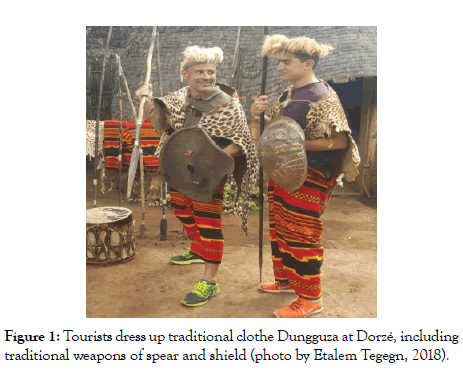
Figure 1: Tourists dress up traditional clothe Dungguza at Dorzé, including traditional weapons of spear and shield (photo by Etalem Tegegn, 2018).
Dorzé people, in addition to Dungguza also have a long history of weaving of other garments such as bullukko, gannaafalla, gaabbi, and, kutta. Bullukko is a large and heavy garment.It is mainly used by men to shield them from the cold air at night. Men also wear it at public gatherings and social occasions like assembly days. Gannaafalla is another variety of indigenous knowledge of weaving from Dorzé. It is nearly the same as bullukko but gannaafalla is smaller. Often, it is offered for the bride from their family as dowry or wedding gift. Another variety, gaabbi, is made from raw cotton. While the rest of weaving products are still largely handmade, kutta can use threads produced by a machine.
Dorzé people are also master weavers on other shemma productions like jano, habesha kemis, and netela. Furthermore, nowadays, they are working even to further diversify their products. The designs, patterns, and colors are also increasingly becoming sophisticated. Local products such as scarves, hats, blankets, cushion covers, table covers, and other home decor items are widely produced in Dorzé village by hand (Figure 2).
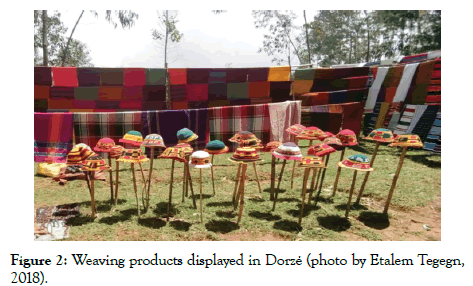
Figure 2: Weaving products displayed in Dorzé (photo by Etalem Tegegn, 2018).
To display for visitors, the main road of the Dorzé village is decorated with colorful weaving products and this circumstance generates unique and attractive scenery for the village. In addition to the products, the artful weaving process itself is provided for visitors as one tourism product (Figure 3).
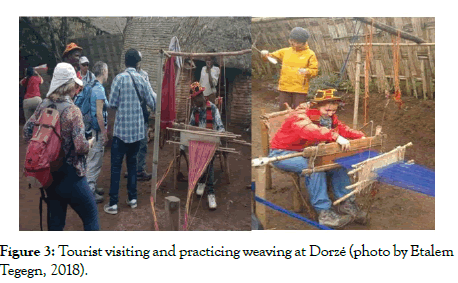
Figure 3: Tourist visiting and practicing weaving at Dorzé (photo by Etalem Tegegn, 2018).
In fact, Ethiopia has a long history of traditional pottery professions and skills. Like other parts of the country, in Dorzé village some community group members specialize in the work of pottery material production. They produce assorted traditional utensils like jebena (Coffee pot), dist (cooking pots), gan (water pot), mitad (baking pan) and souvenirs (Figure 4).
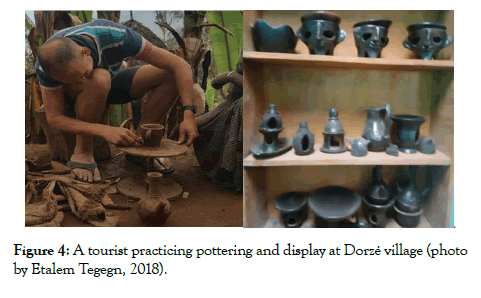
Figure 4: A tourist practicing pottering and display at Dorzé village (photo by Etalem Tegegn, 2018).
Those cultural ornaments and pottering process are recognized as one of the wonderful cultural tourism attraction of the village but, has not been much utilized. Informants from people who have been involved in the production of pottery utensils in the village have complained that there is a high number of tourist flows in the village. However, only a few tourists visit their work. A potter informant stated:
Sometimes, we provide a small number of our pottery products for a few local tour guide associations and individuals but, it’s not sufficient. Generally, we are not that much beneficiary from the tourism development of the village compared to the number of tourist flow into the village (Interview, 8th of December 2018, at Dorzé village).
Elephant-shaped house building in Dorzé village
The elephant-shaped house of Dorzé people is one of the main tourist attractions of the village. As stated above, Dorzé people are well known for their skillful cotton cloth weaving. Besides, their skills are also exhibited in the construction of their houses. Like they do the cloths, the Dorzé people weave together strips of the bamboo tree for the building of elephant-shaped houses.
Indeed, in Ethiopia, different ethnic groups like Sidama, Awi, Sheka, Kaffa and Gumuz predominantly construct their traditional house using bamboo.However, Dorzé house has a great difference in the amount of bamboo used, construction process, design, and durability. Dorzé people only used bamboo for the overall construction of the house.However, other cultural groups mentioned above use some supportive materials such as wood and grass. And, sometimes the other groups dig one or more hardwood poles in the middle of the house, but not in the Dorzé house.
According to Dorzé informants, the process of building an elephantshaped house starts with weaving together half split bamboo strips by making smooth down the roof and wall. At this stage, the house looks like a basket put upside-down. Then, they put up a noseshaped room known as zono on the front side of the house and, they make two eyes known as lecheke on the left and the right sides. As a final point, they thatch the roof by bamboo stems.In this way at the end, they build an elephant-shaped house (Figure 5).

Figure 5: Dorzéhouses building in progress, and tourist visiting (photo by Etalem Tegegn, 2018).
The house which was properly constructed and thatched can last from 60 to 80 years. This testifies the highly durable quality of the house like no other houses built by other cultural groups. In fact, the selection of appropriate bamboo species and harvesting it in a suitable season plays a role in the durability of the house. There are a lot of species of bamboo in Dorzé villages; nevertheless, for the building of the body of the house, the Dorzé prefer matured and dried xarzo and loodo bamboo species. Besides, they believe that the dark time (it depends on the moon) is the appropriate time for harvesting.Dorzé people also use smoke as a natural treatment mechanism to keep the house structure strong and resistant to pest attacks.
At a compound, three houses are often commonly found including the main house, kitchen and honeymoon. The main house’s height is up to twelve meters and has different partitions. What is interesting about the house is the nose-shaped room serves as a reception room for guests like hotels. Tourists are often welcome in this room. This room is positioned in the front part of the house and furnished with two benches for seating; it is ready at all times for guests to be welcomed. In the middle of the house, there is an open fire for cooking. In addition, cattle shed, sleeping place and storage rooms are found independently in this main house. Portability is also the other extraordinary characteristics of the elephant-shaped house of the Dorzé people. The whole structure of the house can be safely moved and re-located to a new place at the same compound or far from it.
The Dorzé house generates interest for visitors. Unfortunately, many villagers are replacing their houses with corrugated iron sheets. This unique rural house architecture is threatened.
Masiqqala festival of Dorzé people
From the beginning of September, one similar to the New Year celebration of Ethiopia, Masiqqala celebration goes up to the end of the month colorfully. The Dorzé ancestors celebrated Masiqqala festival at the end of the crop cultivation season which also roughly coincides with the time of the beginning of the New Year cultural festival. Mainly, they gather intending to give thanks to Tosa, which is the local name for God, for what they have been blessed throughout the year and to pray for the future to have good things. Today’s Dorzé also keep celebrating Masiqqala festival but together with the celebration of the day of Finding of the True Cross. Together with Masiqqala festival, different cultural practices occur in the village such as women’s day (sofe masiqqala) and slaughtering day (shuhuaqamma).
The women’s day is an important cultural exercise in Dorzé community. While the international community dedicates only March 8 as the international day of women, the Dorzé community dedicates seventeen days in a year.In each month of a year, the Dorzé women have one day of freedom which is always the 21st of each month according to the Ethiopian calendar. Besides, on the occasion of Masiqqala festival in September, women get five continuous days of freedom. In all these days, women are free from any domestic chores and they spend those days enjoying and playing with their friends. However, like other cultural aspects, the place of women in Dorzé is not studied and acknowledged among academics and government practitioners.
There are three different traditional ways to get married in the Dorzé community, i.e., mako, dafa (kidnap), and sorro. In mako traditional marriage, the bride willingly leaves her father’s house for that of a man she likes, without the knowledge or permission of her father. Following this, an intermediary, or lazantsa, makes peace between the two households. In dafa marriage, the groom or his father kidnaps the girl on the road, or at a market, or in the fields. The most proper form of traditional marriage is sorro, which takes place based on the willingness of the girl and her family [3].
Then, in sofe masiqqala event, all newly wedded women come on horseback to a market compound and they appear for their families, friends, and relatives. To be the front-runner of sofe event, they take good care of their beauty. Accordingly, they wear cultural clothes, and they smear their hair with butter and they cover it with a piece of cloth. The event grabs the attention of everybody who happened to visits such a tradition.
The woga masiqqala festival is held in Dorzé from September 14 up to 17 Ethiopian calendar (Sep 24-27 Gregorian calendar). The inimitable practices of slaughtering bulls come to pass between those days. The slaughtering day (shuhuaqamma) is adjusted and regulated by respected village elders in selecting the nearest market day to the festival. As a result, slaughtering day varies from year to year.On a designated day, the festival opens by local elders with prayers and thanksgiving for Tosa, God, for his blessings, provision, and peace in the community. Then, the people start the celebration by saying “Masiqqala Yoo…Yoo…Yoo” meaning that happy Masiqqala celebration.
A day before the slaughtering day, the people eat food at the family level, the food called kesokath. Then, the family members of all households have to attend this event.Not showing up to this event is culturally intolerable. After this day, the slaughtering of the bulls takes place on a big field of usually a marketplace called bodo. Usually, 700 to 1000 bulls are slaughtered in one day in the Dorzé village. This makes Dorzé Masiqqala celebration unique and attractive. After slaughtering, people sit in groups and they eat raw meat with kocho and spices in the same place the bulls are slaughtered. And they drink strong local liquors called arake, teji and other traditional drinks (Figure 6).
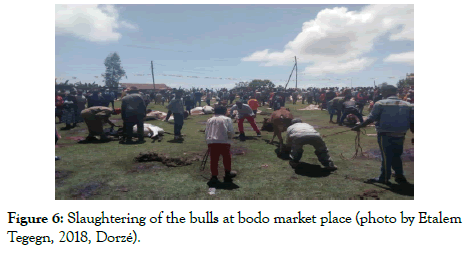
Figure 6: Slaughtering of the bulls at bodo market place (photo by Etalem Tegegn, 2018, Dorzé).
The other exciting and thrilling thing is when people meet with friends, they jump and shout with saying “Yoo, yoo, yoo!” and then the others reply with a long “Yooooooo!” Then they hug each other with long laughs.
The other imperative and colorful event of the festival is lighting a massive bonfire known as xomppe. The celebration of xomppe in the Dorzé village coincides with the same day and is celebrated in the same manner with the celebration of damara by other parts of the country, a celebration made a day before the celebration that commemorates the Finding of the True Cross.
Mataethoqamma is another package of Masiqqala celebration which takes place after three days of the slaughtering day. This event is considered by villagers as “family festival”. Because of that, all family members come together to a selected elder house for an attractive event as a group. All those collected families celebrate this festive with feasting, enjoying and talking about different family issues. In this event, all family members bring unique and selected white flowers with green grass for their elder families as a gift. This gift symbolizes love, respect, and wish for a long-life. In this respect, elders give their blessing to families. However, this cultural event is not well known
Traditional squares, known as dubusha, are one of the unique cultural tourism potentials of the village. Dubushas are large squared places that were used by Dorzé community to gather and share their different social and cultural aspects. It is a place where people assemble to deliberate community matters. For example, a dubusha is mainly used by dwellers of a village as the public meeting place for elders to solve conflicts peacefully. It is also used for mourning practices and for celebrating social, cultural, and religious festivities.
Lakadubusha is especially a unique and much-respected squared place in Dorzé community. It accommodates meetings of community throughout the year with different aspects. Moreover, once in a year, it hosts and accommodates all Dorzé community with taking part in Masiqqala celebration. This day is called by the local community “Laka Qamma” or “Day of Laka”. On this day all twelve kebeles people come together and converge to celebrate Masiqqala by dancing and singing in a very inspiring and exciting way. Furthermore, in this day political, economic and social issue discussion practices are included as the most important part of the celebration. With this aspect, if conflicts have been raised between communities, traditional conflict resolution or negotiation is carried out by village elders in this place and day.
This Dubusha place has a great significance for the villagers to keep unity, happiness, peace, and security for an elongated time. Furthermore, exercise transpired in that place play their part in sustainably preserving and transferring the villager’s old cultures, customs, norms, and traditions for the next generation. This traditional squares place has a great socio-political value for the villages with serving as a source of identity, interaction, and coherence of Dorzé people.
Dhuffe Masiqqala is celebrated in Dorzé village on September 28 or 30 E.C (October 8 or 10 Gregorian calendar) and it is celebrated equivalently to Woga Masiqqala the main Masiqqala festival with the slaughtering of the bulls. The only difference is the number of bulls for slaughtering is small in Dhuffe Masiqqala. So, if tourists cannot attend Woga Masiqqala, Dhuffe Masiqqala provides another chance.
The inauguration and closing ceremony of the festival practice are facilitated by local elders that they pray and wish for their community prosperity, unity, strength, health, love, and peace throughout a year. Before, closing the festival at the night time, all Aleka or representatives gather together and then they slaughter one bull.This bull locally called Gelado Bora and it symbolizes the end of Masiqqala festival peacefully. After three days of Dhuffe Masiqqala comes an event called “Hero Heretho” or the chasing day of Masiqqala. On this day, the Dorzé community finalizes the festival by chasing Masiqqala out by saying “Masiqqala, as you came peacefully please go peacefully and come peacefully next year”.
As detailed in the above, associated with the Masiqqala festival different attractive cultural events take place from September 10thto October 10thin the village. Accordingly, if tourists come to the village within this period, they can get the opportunity to be a part of one or more events of the Masiqqala festival. This festival in addition to serving as a tourist attraction has a number of other contributions for the local community. From the economic perspective, it creates employment opportunities.Besides, as a religious festival, it has a great spiritual value for the villagers. From the socio-political perspective, it has a comprehensive contribution to keep the villagers’ interaction and unity from the family level to the whole community. So, those uncountable values of Masiqqala festival need to be known to and visited by people in other parts of Ethiopia as well as the world.
Traditional music instruments of the Dorzé people
Ethiopia is not only treated as the cradle of mankind but also as the motherland of music, songs, art and culture. Ethiopia upholds a unique cultural heritage and diverse music history in the entire African continent [11]. In the country, various ethnic groups have their own distinct traditional music instruments like masinko, krar, washint, begena, and kebero. As widely known, most of the traditional music instruments are made from wood, bamboo, animal skin, as well as an animal horn to mention a few. The Dorzé people have a unique traditional music instrument called Eddo from which the sound is only produced by human tunes without using any other tangible materials, which is different from other musical sounds of other modern and traditional instruments. Unlike many other musical instruments, Eddo produces seven different sounds or nota namely Ayphe, Ayphekaletho, Dhunbe, Dhunbekaletho, Tucha, Phila, and Philakaletho. For each sound, there are some people who have specialized in it. Eddo music play is started by Ayphe and then the others follow according to the order they are mentioned above.Dorzé people use human sound as an instrument for their traditional music. Unfortunately, this unique traditional knowledge is not acknowledged and documented. It is not also promoted and used as tourism products.
In addition to Eddo, like other ethnic groups of the country, the Dorzé use other traditional music instruments, which are made from tangible materials such as Zayee (local trump), Dithaa (kirar), and Kabaro (Drum). Besides, Dorzé people use Bullukko or the largest artifact of the weaving tradition as a musical instrument by beating like drums. Bullukko is commonly used by Dorzé women in weddings, funerals, festivals, and other social events.
The process of making food from enset and culinary experiences
Ethiopia is one of the centers of origin for various crops. Enset (false banana, scientific name: Ensete ventricosum) is one of the endemic or native plant species which is found in the highlands of south and southwestern Ethiopia including the Dorzé village [12].
This non-woody plant physically resembles the banana plant, but it is taller and fatter than a banana tree. It is a root crop that does not give fruits like banana, as a result it is called "false banana". The products of this plant have high nutritional value. As a result, it has been considered as delicious food in different parts of the country.
Dorzé people have cultivated it at large agricultural land or in their small garden area. When Enset is fully grown, the Dorzé prepare various foods such as Kocho (also known as Uncca¸ which is a flatbread) and Itima (porridge). According to the local community, Enset plant takes four or five years for maturation. When it ready for harvest, it gives flowers or a few fruits. At that stage, the Dorzé cut it and stretch the pith of stem or trunk. And the pulverized stem is buried in the ground for 3 to 6 months. Finally, people get a tasty kocho. Kocho is eaten in the form of ukeththa (bread), shendera (porridge), and enccila after being fermented and boiled. From the other part of this plant, they gain Bulla and Deshuncha products. Bulla is the yield from the liquid squeezed out of the mixture. It is whitish and it mostly prepared for newly delivered women, highly respected guests, holidays and wounded persons [13]. Deshuncha is the fresh underground part of Enset, it is commonly used to prepare different types of traditional foods, or it can be eaten even after cooking it like potatoes.
The process of making food from the Enset plant, even though partially, is currently presented for tourists as an important tourism product of the area in Dorzé village. Tourists presently can also eat the foods from this plant, commonly ukeththa (flat bread). Other foods and drinks for tourists include different local spices, honey and local drink known as Hareke (Figure 7).
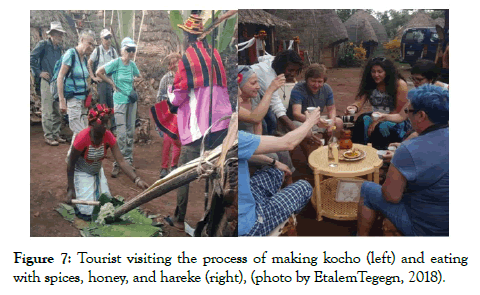
Figure 7: Tourist visiting the process of making kocho (left) and eating with spices, honey, and hareke (right), (photo by EtalemTegegn, 2018).
An interviewee from tourists said:
I enjoyed the demonstration of making the kocho. Every part of the tree is used either for food, or for cooking on the leaves, making ropes, and roofing house materials. I had seen how the stem of a banana could be turned into bread. I tried on local costumes and tasted the home-brewed Hareke and delicious kocho bread with honey and fiery sauce. It was just marvelous and surprisingly good (Interview, tourist, 11th of August 2018, at Dorzé village).
In doing so, tourists get the chance to absorb new cultural practice plus, they get the chance to have culinary experiences with test new meals. This circumstance can be taken as a strength of Dorzé village as a tourist destination.
Accessibility and tourism infrastructures of dorzé village
Accessibility is another most important criterion to evaluate the potential of a tourism destination. Accessibility refers to the ability to reach a tourist attraction, depending on the significance of the attraction’s location, the availability of travel modes, and the quality of road networks [5]. Specifically, the geographical location of an area is an important element of tourism potential and that a destination that is easily accessible for a variety of tourists has an advantage over other sites which are more inaccessible [14]. Regarding the accessibility of the area, findings confirm that the geographical location of Dorzé village has a high level of accessibility for visitors because, the village is situated at a distance of 28 km from Arba Minch, the principal town of Gamo Zone and a popular tourist destination of southern Ethiopia.
In fact, in addition to geographical location, full-fledged infrastructure facilities such as quality road, water, and electric power supply play an important role in improving tourism sector development at a certain destination. As one comes down to the study area, lack of quality road infrastructure is a stumbling block for the tourism development of the Dorzé village. As the authors of this paper have observed during the fieldwork and as interview participants explained, on the main road of Dorzé there are dangerous turns, and slopes, which are affecting the safe movement of vehicles as well as visitors especially in the rainy season from roughly from June to October (Figure 8).
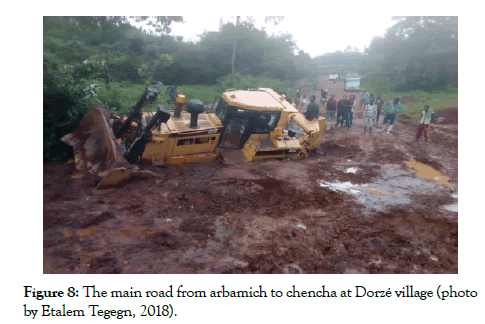
Figure 8: The main road from arbamich to chencha at Dorzé village (photo by Etalem Tegegn, 2018).
In addition to that, a lack of a bank, internet, water, and electric power supply is identified as the other obstacles to the development of tourism in the village.
Accommodation facilities of the dorzé village
Like the infrastructure, the economic expansion of tourism at a certain tourism destination community also has depended on accommodation facilities and tourists’ length of stay. In Dorzé village only Stehaye or Dorzé Lodge give partial accommodation facilities with a few rooms, food and beverage services for visitors. Due to lack of accommodation provision of the area, tourists stay only for a few hours in this compound then they drive to Arbaminch to spend the night. This has greatly limited the tourists’ length of stay in the Dorzé village.Regarding this, one of the informants from the local guides regretted as follows. According to him, tour guides like him wanted to provide various tourism products to visitors in the Dorzé village such as mountain trekking, horse riding, and walking to sentinel natural gorgeousness of the village. Besides, when the tourists come back from such tourism activities, they wanted to provide coffee ceremony, night campfire, impressive traditional dance and music with the villagers. But, these all things can be possible only when there is accommodation for the tourists to stay the night in the Dorzé village. Due to lack of accommodation provision, the tour guide regrets that he and other tour guides like him as well as the villagers could not benefit from the local tourism. Hence, the concerned body should have to take the duty to improve tourism infrastructure in the Dorzé village this problem (Interview, local tour guide, 10thof September 2018, at Dorzé village).
The study ascertained that Dorzé village is gifted with both natural and cultural tourism potentials. However, some tourism products especially natural attractions and some cultural tourism resources are not effectually exploited for area tourism development and product diversification. The lack of tourism infrastructures like roads, banks, the internet, water, and electric power supply is identified as stumbling blocks for up-and-coming tourism development of the Dorzé village. Lack of accommodations provision is also identified as the other bottleneck of cultural tourism development in the area. Because of those aforementioned problems, visitors stay only for a few hours. For those shortcomings, the researchers suggest that tourism stakeholders including the government need to improve tourism infrastructure and accommodation provisions in the Dorzé village.
Citation: Tegegn E, Amsalu D, Tefera T (2020) Cultural Tourism Potentials of the Dorzé Village, Southern Ethiopia. J Tourism Hospit 9:438. doi:10.35248/2167-0269.20.9.438.
Received: 24-Jul-2020 Accepted: 07-Aug-2020 Published: 14-Aug-2020 , DOI: 10.35248/2167-0269.20.9.438
Copyright: © 2020 Tegegn E, et al. This is an open-access article distributed under the terms of the Creative Commons Attribution License, which permits unrestricted use, distribution, and reproduction in any medium, provided the original author and source are credited.